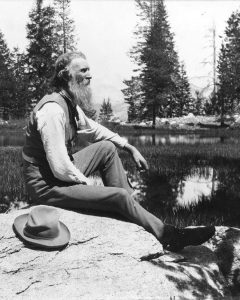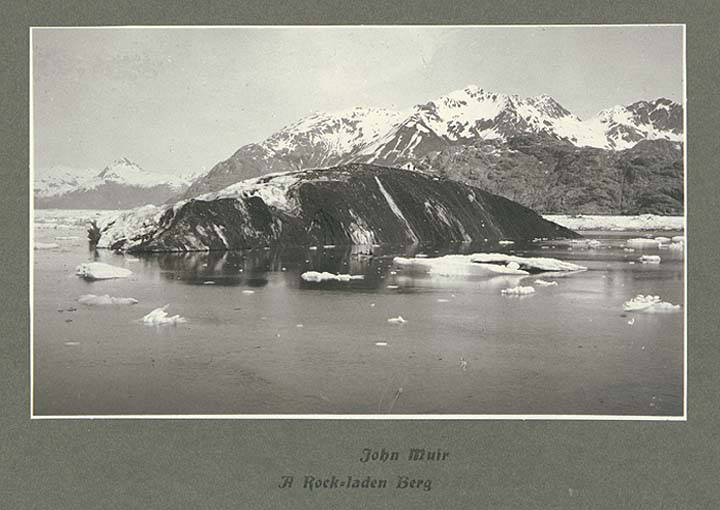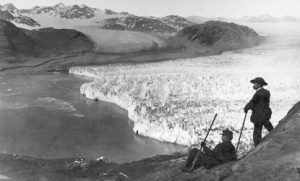12 The Discovery of Glacier Bay
John Muir

About the author
John Muir earned his nickname “The Father of the National Parks,” by being the foremost American naturalist of his age. Born in Scotland in 1838, he spent most of his life in the US exploring what remained of the American wilderness. He worked with the likes of Teddy Roosevelt to create the first National Parks and wrote numerous memoirs of his travels. First in California’s Sierra Nevada Mountains, and later in southeast Alaska, Muir raised awareness of the value of the rare beauty of untouched nature just as the rapid growth of the nation’s East Coast population had all but erased such places.
Muir visited Alaska three times. The text below is an excerpt from Muir’s final book, Travels in Alaska. Muir uses vivid sensory language to describe his “discovery” of Glacier Bay, now also a National Park. Muir was almost certainly the first European to lay eyes on it, but the idea that he discovered the Bay does not do justice to the Native Tlingit and Haida clans who had lived and fished around the bay for centuries.
NOTE: Muir was a product of his age, and this includes his use of the inaccurate and insensitive term “Indian” to label the Tlingit guides who accompanied his team.[1] While I do not endorse the use of this term, I have chosen to leave Muir’s text as written to serve as an example of how such language flattens culture and erases identities. Even well-meaning authors like Muir can fall prey to hurtful policies adopted without question.

After supper, crouching about a dull fire of fossil wood, they became still more doleful, and talked in tones that accorded well with the wind and waters and growling torrents about us, telling sad old stories of crushed canoes, drowned Indians, and hunters frozen in snowstorms. Even brave old Toyatte, dreading the treeless, forlorn appearance of the region, said that his heart was not strong, and that he feared his canoe, on the safety of which our lives depended, might be entering a skookumhouse of ice, from which there might be no escape; while the Hoona guide said bluntly that if I was so fond of danger, and meant to go close up to the noses of the ice-mountains, he would not consent to go any farther; for we should all be lost, as many of his tribe had been, by the sudden rising of bergs from the bottom. They seemed to be losing heart with every howl of the wind, and, fearing that they might fail me now that I was in the midst of so grand a congregation of glaciers, I made haste to reassure them, telling them that for ten years I had wandered alone among mountains and storms, and good luck always followed me; that with me, therefore, they need fear nothing. The storm would soon cease and the sun would shine to show us the way we should go, for God cares for us and guides us as long as we are trustful and brave, therefore all childish fear must be put away. This little speech did good. Kadachan, with some show of enthusiasm, said he liked to travel with good-luck people; and dignified old Toyatte declared that now his heart was strong again, and he would venture on with me as far as I liked for my “wawa” was “delait” (my talk was very good). The old warrior even became a little sentimental, and said that even if the canoe was broken he would not greatly care, because on the way to the other world he would have good companions.
Next morning it was still raining and snowing, but the south wind swept us bravely forward and swept the bergs from our course. In about an hour we reached the second of the big glaciers, which I afterwards named for Hugh Miller. We rowed up its fiord and landed to make a slight examination of its grand frontal wall. The berg-producing portion we found to be about a mile and a half wide, and broken into an imposing array of jagged spires and pyramids, and flat-topped towers and battlements, of many shades of blue, from pale, shimmering, limpid tones in the crevasses and hollows, to the most startling, chilling, almost shrieking vitriol blue on the plain mural spaces from which bergs had just been discharged. Back from the front for a few miles the glacier rises in a series of wide steps, as if this portion of the glacier had sunk in successive sections as it reached deep water, and the sea had found its way beneath it. Beyond this it extends indefinitely in a gently rising prairie-like expanse, and branches along the slopes and canyons of the Fairweather Range.

From here a run of two hours brought us to the head of the bay, and to the mouth of the northwest fiord, at the head of which lie the Hoona sealing-grounds, and the great glacier now called the Pacific, and another called the Hoona. The fiord is about five miles long, and two miles wide at the mouth. Here our Hoona guide had a store of dry wood, which we took aboard. Then, setting sail, we were driven wildly up the fiord, as if the storm-wind were saying, “Go, then, if you will, into my icy chamber; but you shall stay in until I am ready to let you out.” All this time sleety rain was falling on the bay, and snow on the mountains; but soon after we landed the sky began to open. The camp was made on a rocky bench near the front of the Pacific Glacier, and the canoe was carried beyond the reach of the bergs and bergwaves. The bergs were now crowded in a dense pack against the discharging front, as if the storm-wind had determined to make the glacier take back her crystal offspring and keep them at home.
While camp affairs were being attended to, I set out to climb a mountain for comprehensive views; and before I had reached a height of a thousand feet the rain ceased, and the clouds began to rise from the lower altitudes, slowly lifting their white skirts, and lingering in majestic, wing-shaped masses about the mountains that rise out of the broad, icy sea, the highest of all the white mountains, and the greatest of all the glaciers I had yet seen. Climbing higher for a still broader outlook, I made notes and sketched, improving the precious time while sunshine streamed through the luminous fringes of the clouds and fell on the green waters of the fiord, the glittering bergs, the crystal bluffs of the vast glacier, the intensely white, far-spreading fields of ice, and the ineffably chaste and spiritual heights of the Fairweather Range, which were now hidden, now partly revealed, the whole making a picture of icy wildness unspeakably pure and sublime.
Looking southward, a broad ice-sheet was seen extending in a gently undulating plain from the Pacific Fiord in the foreground to the horizon, dotted and ridged here and there with mountains which were as white as the snow covered ice in which they were half, or more than half, submerged. Several of the great glaciers of the bay flow from this one grand fountain. It is an instructive example of a general glacier covering the hills and dales of a country that is not yet ready to be brought to the light of day—not only covering but creating a landscape with the features it is destined to have when, in the fullness of time, the fashioning ice-sheet shall be lifted by the sun, and the land become warm and fruitful. The view to the westward is bounded and almost filled by the glorious Fairweather Mountains, the highest among them springing aloft in sublime beauty to a height of nearly sixteen thousand feet, while from base to summit every peak and spire and dividing ridge of all the mighty host was spotless white, as if painted. It would seem that snow could never be made to lie on the steepest slopes and precipices unless plastered on when wet, and then frozen. But this snow could not have been wet. It must have been fixed by being driven and set in small particles like the storm-dust of drifts, which, when in this condition, is fixed not only on sheer cliffs, but in massive, overcurling cornices. Along the base of this majestic range sweeps the Pacific Glacier, fed by innumerable cascading tributaries, and discharging into the head of its fiord by two mouths only partly separated by the brow of an island rock about one thousand feet high, each nearly a mile wide.
Dancing down the mountain to camp, my mind glowing like the sunbeaten glaciers, I found the Indians seated around a good fire, entirely happy now that the farthest point of the journey was safely reached and the long, dark storm was cleared away. How hopefully, peacefully bright that night were the stars in the frosty sky, and how impressive was the thunder of the icebergs, rolling, swelling, reverberating through the solemn stillness! I was too happy to sleep.
Source:
Muir, John, Travels in Alaska, New York: Houghton Mifflin, 2015.
- John Muir and Alaska, National Park Service, https://home.nps.gov/jomu/learn/historyculture/john-muir-and-alaska.htm ↵
sad
agreed; granted power
waterfalls
lonely
jail [Muir's note]
Tlingit Alaska native from the village of Hoonah.
clear like water
cruel, harsh
Mountain range along the Canada/US border
unchanging
pure
beauty of grand, noble, or spiritual quality
rippling, like waves

